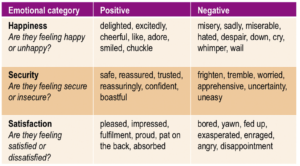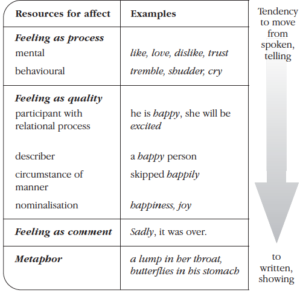Effective writers and speakers are able make language choices across the text to engage their audiences, creating a sense of solidarity with them and influencing them to share their view of the world.
Our students need to learn how to do this and particularly how to make their stance clear in the patterned ways that are valued by the various curriculum areas and bands of schooling. They also need to be aware, as listeners and readers, of the ways that speakers and writers use language to position their audiences so that they can choose whether or not they wish to accept that viewpoint.
Expression of emotion is most widely used in narratives and personal recounts, where speakers and writers share their feelings, or the feelings of their characters. These expressions of feelings and emotions help listeners or readers to relate to and empathise with them as the narrator and/or protagonist and to dislike, or react against, the ‘villains’.
The language of affect
First, let us have a look at the language of affect. There are 3 emotional categories – happiness, security and satisfaction – which can each be divided into positive and negative.
Students can engage in various activities to build word banks for each category. They can also consider how to grade their meanings; that is, how word choices can vary the intensity of the emotion expressed.
Grading emotions
We can then turn the expression of emotion up or down by adding:
- intensifiers (eg kind of, sort of, really, so much, a little bit)
- repetition (eg I hated it, really hated it)
- intonation
or by loading the lexis (choosing a word with inbuilt intensity).
Grammatical resources
Aside from considering expressions of affect according to categories of emotion, we can also consider which grammatical resources have been chosen.
©Lexis Education, 2019



